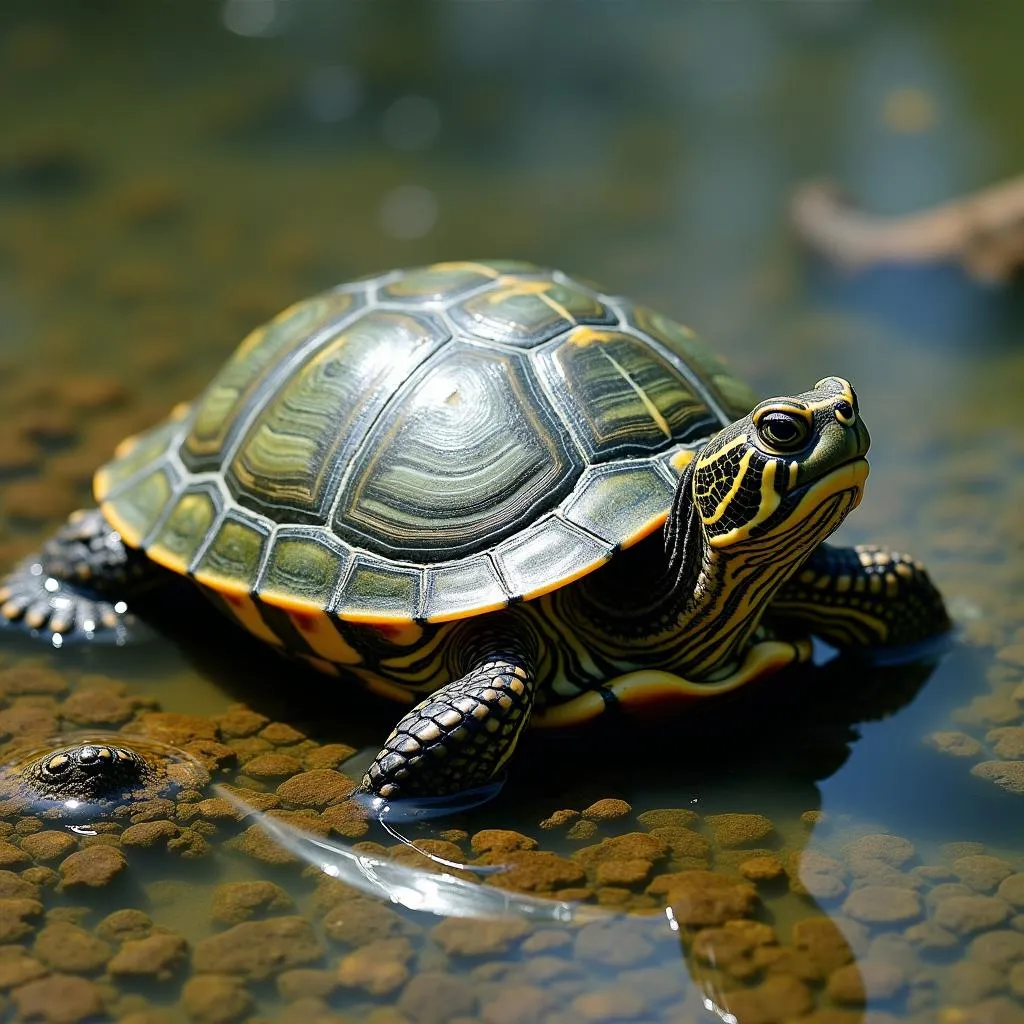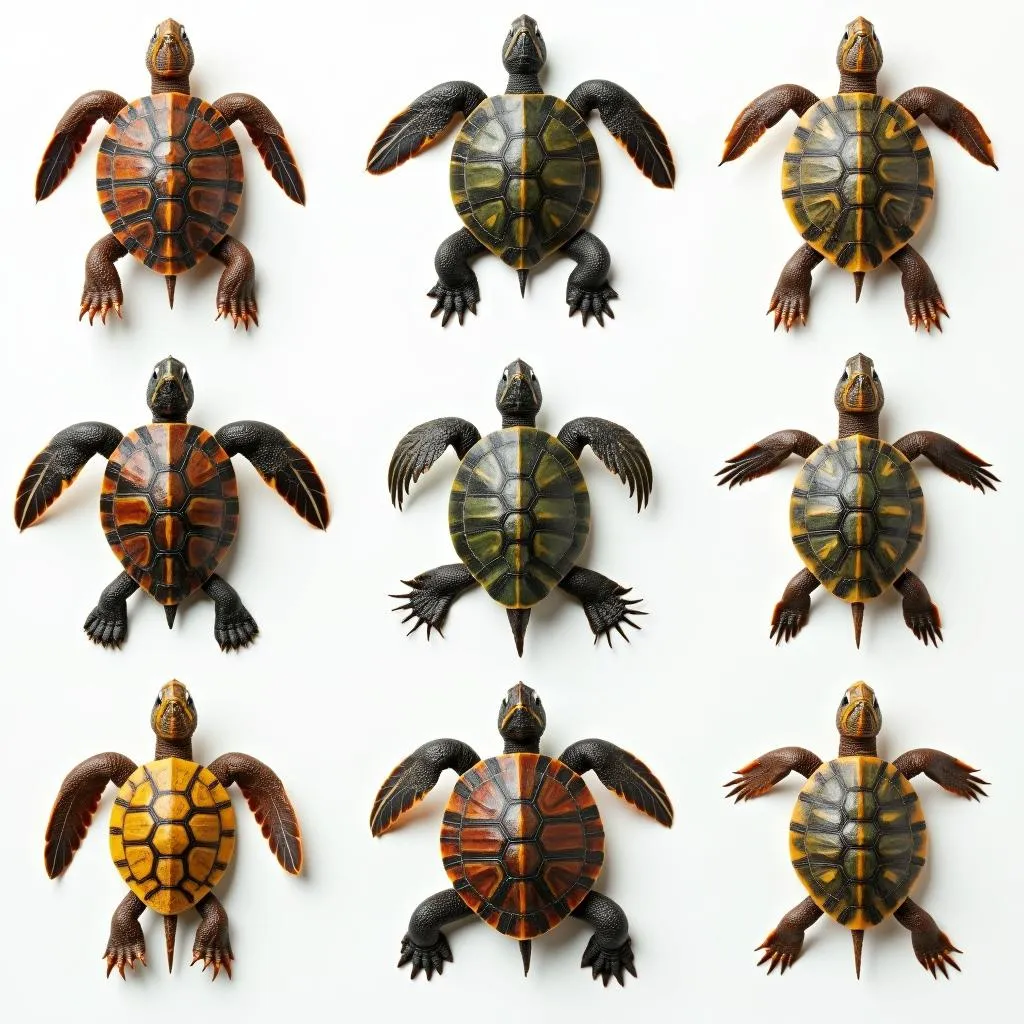Turtles are fascinating creatures with a rich history and diverse range of characteristics. One question that often pops up is “what color are turtles?” The answer, like many things about these reptiles, is not so simple. In fact, there’s a whole rainbow of colors and patterns displayed in their shells and skin. So, let’s dive into the world of turtle colors, uncovering the secrets behind their diverse appearances.
The Colorful World of Turtle Shells
The most striking feature of a turtle is its shell, which is a protective armor that helps them survive in various environments. The color of a turtle’s shell can vary widely depending on the species, age, and even its habitat.
Green: The Classic Turtle Color
Many people think of green when they picture a turtle. Green is a common color for many species like the Eastern Painted Turtle and the Red-eared Slider. The green coloration provides camouflage in their wetland habitats, blending in with the surrounding vegetation.
Brown and Black: Blending with the Earth
Other species, such as the Snapping Turtle and the Wood Turtle, sport shades of brown and black. These colors help them camouflage with the forest floor, rocks, and muddy banks, allowing them to blend in and avoid predators.
Yellow and Red: A Splash of Color
While green, brown, and black are the most common colors, some turtles exhibit a vibrant display of yellow, red, and orange. The Eastern Painted Turtle, as the name suggests, has a shell decorated with intricate patterns of yellow, red, and orange. This bright coloration is believed to help them attract mates and warn off rivals.
Patterns and Markings: A Unique Signature
Besides solid colors, many turtle species have intricate patterns and markings on their shells. These patterns can include stripes, spots, and even geometric designs. These unique markings serve as a way to differentiate between individuals and even different subspecies.
The Role of Camouflage: A Defense Mechanism
The color and pattern of a turtle’s shell are essential for survival. The camouflage it provides helps them blend in with their surroundings, avoiding predators and ambushing prey.
 Turtle Shell Camouflage: Blending In with the Environment
Turtle Shell Camouflage: Blending In with the Environment
The Color of a Turtle’s Skin
While the shell is the most noticeable feature, the color of a turtle’s skin also varies significantly.
Green and Brown: The Common Skin Tones
Green and brown are the most common skin colors for turtles. These tones help them blend with their habitats, providing additional camouflage.
Bright Colors: Signaling and Communication
Some turtles have brightly colored skin, especially on their heads and necks. These bright colors can serve as a warning signal to predators or be used for courtship displays.
Variations Based on Species
The skin color of a turtle is also influenced by the species. The Eastern Painted Turtle has bright red skin on its head and neck, while the Snapping Turtle has a gray, mottled skin.
Factors Influencing Turtle Color
The color of a turtle is determined by several factors:
- Species: Each species has its own unique color variations, which are often influenced by its habitat and diet.
- Age: As turtles grow older, their shell and skin colors can change and even fade.
- Diet: A turtle’s diet can influence the color of its shell and skin. For example, a diet rich in carotenoids can result in brighter coloration.
- Habitat: The environment in which a turtle lives can also impact its coloration. Turtles in sunny areas may have brighter colors than those living in shady areas.
 Turtle Color Variations: A Spectrum of Colors
Turtle Color Variations: A Spectrum of Colors
“What Color Are Turtles?” A More Complex Question
So, what color are turtles? The answer is that there isn’t a single color that defines all turtles. Instead, it’s a kaleidoscope of colors and patterns, each with its own unique story.
Expert Insights:
“Turtles are masters of camouflage, and their shell and skin colors are crucial to their survival. Understanding the diverse range of colors and patterns allows us to appreciate the amazing adaptability of these fascinating creatures.” – Dr. Emily Carter, Herpetologist and Conservation Biologist
What Color is Your Favorite Turtle?
Now that you’ve explored the world of turtle colors, which color is your favorite? Share your thoughts in the comments below!